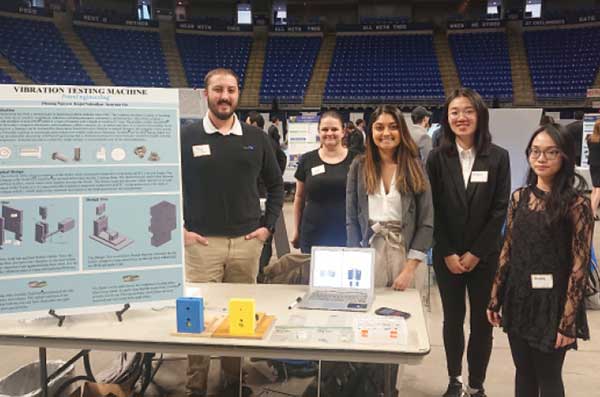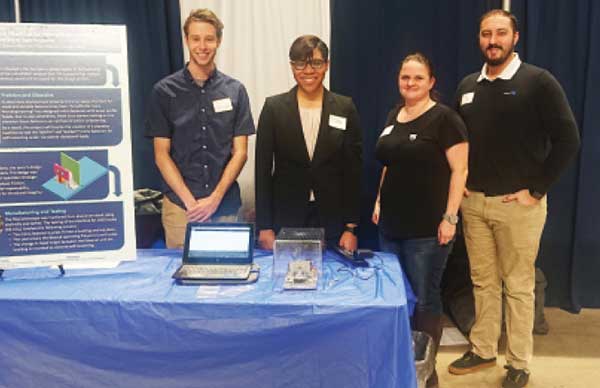Solving Real-World Engineering Problems
Student Design Competition Profile: Penn State Capstone Design Program

Through the Capstone Design program, students solve real-world challenges for sponsoring companies. Image courtesy of Penn Engineering.
Latest News
May 15, 2020
The Bernard M. Gordon Learning Factory helps coordinate 200 senior Capstone Design projects from industry sponsors and professional clients each year within Penn State’s College of Engineering. These semester-long projects give engineering students the opportunity to solve real-world challenges, such as PennEngineering’s need to test a tiny fastener’s functionality under vibration loads.
Chris Aldred is the senior marketing communications manager at PennEngineering, and Zachary Light is the market manager for the company’s MicroPEM fastener line.
We spoke with Aldred and Light to learn about PennEngineering’s support of and experience with Penn State’s Capstone Design program. Our conversation helped us gain further insight into their competition.
Digital Engineering: Can you provide an overview of the Capstone Design program and why PennEngineering sponsored a project? What was the project, and who participated in the project?
Chris Aldred: Penn State has the largest multidisciplinary Capstone program in the world. They had about 200 projects last semester. At most universities, mechanical engineers are usually grouped with other mechanical engineers in their Capstone program. Penn State’s approach allows for engineering students from many different disciplines to work together on a project, and that was of interest to us because we had a problem that needed know-how from multiple disciplines to solve.
Zachary Light: As a company, we sell fasteners to the automotive electronics industry for things like sensors and backup cameras, and there is a trend toward smaller components packed into smaller spaces. Cars are subjected to long periods of intense vibration, and fasteners have to do their jobs even under these conditions. Screws have a tendency to back out under vibration, so a clinch fastener can be a good solution.

Automotive electronics manufacturers need to know the fasteners they’re using won’t fail, so it’s necessary to test every component against vibration. In the past, it’s been possible to vibration test fasteners, but the drive toward smaller components has resulted in fasteners that are too small for the existing vibration test machines to handle.
We challenged two Capstone groups last semester to devise a machine to test the ability of our micro fasteners to withstand vibration. The groups included mechanical, electrical and software engineering students, and that worked well because the mechanical engineering students could design the physical structure of the machine, while the electrical engineering students could supply the electrical expertise, and the software engineering students could write the code to run the machine.
DE: Tell us more about the projects.
Light: The smallest fastener that commercially available vibration testing machines can handle is 3 mm in diameter. At 1 mm in diameter, our micro fasteners are a third the size of that. There is no machine capable of holding the tolerances necessary to test such a small fastener. At the same time, the automotive electronics industry has very stringent requirements for component performance.
Our two student teams worked all of last semester coming up with a way to accurately test the performance of our TackPin and TackSert micro fasteners against self-loosening under vibration loads. The four-person team created one vibration testing prototype out of aluminum, and the five-person team 3D printed two variations of their vibration testing prototype.
This semester, we are sponsoring one group consisting of four industrial engineering students and one mechanical engineering student. Their task is to test our micro fasteners in the machines and collect and analyze the data as well as the performance of the three machines themselves.
DE: Can you provide some examples of what you expect the projects to produce?
Light: Depending on how well the machines work during testing this semester, we might share the team’s test results with potential buyers of our micro fasteners in the automotive electronics industry. Alternatively, we might find it would benefit us to develop a vibration testing machine refined from one of the prototypes.
Moving forward, we anticipate supporting more Capstone Design projects to meet other engineering and business challenges.
DE: Does Penn State or the Learning Factory have a particular stance on adopting an innovation that is linked to the program?
Aldred: Students participating in the Capstone Design program automatically hold intellectual property (IP) rights on anything they create unless the sponsor negotiates for the IP rights. Because we are trying to solve a specific business and engineering challenge, we negotiated for those rights.
The students knew about the IP agreement before they took on the projects. They get experience solving a real-world problem, they have the opportunity to interact with a potential future employer and they have something real to show for their effort.
The Learning Factory’s main interest is in the education and experience the students are getting.
DE: What drives firms to sponsor a project in the Capstone Design program?
Aldred: We are interested in sponsoring projects in the program for a couple of reasons. First, we had a business and engineering challenge that we thought could be uniquely and economically addressed through a Capstone Design project. Second, we want to forge a long-term relationship with Penn State, which is only about three hours away from our headquarters in Danboro, PA.
Some of the finest engineering minds obtain their degrees from Penn State, and the multidisciplinary nature of the Capstone Design program means we have access to a tremendous mix of engineering skills. We are excited by the chance to work with these students and help the upcoming generation of engineers gain experience and learn about fastener technology. We may even identify potential future employees through our support of the Capstone Design program.
DE: Anything else you’d like to tell us about the program that the above questions haven’t given you the opportunity to express?
Aldred: Based on the experience we’ve already had with supporting the Penn State Capstone Design program, PennEngineering expects to expand sponsorship of such programs to other leading universities. This way, we can help provide real-world experience to more engineering students.
Subscribe to our FREE magazine, FREE email newsletters or both!
Latest News
About the Author
Jim Romeo is a freelance writer based in Chesapeake, VA. Send e-mail about this article to [email protected].
Follow DE





